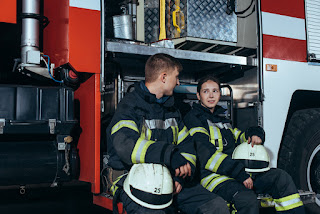Over time, the frequency of these experiences can contribute to lingering effects and negative symptoms – intrusive memories, nightmares, changes in thinking and mood. These behaviors are often diagnosed as post-traumatic stress disorder (PTSD). But there’s another phenomenon that first responders may experience when they commit to working through these emotions: post-traumatic growth. Developed by psychologists Richard Tedeschi, PhD, and Lawrence Calhoun, PhD, in the 1990s, post-traumatic growth is the ability to process trauma and emerge from a traumatic or stressful situation even stronger than before.
This PTSD Awareness Day, let’s learn about the profound and transformative experience of post-traumatic growth and strategies for cultivating a growth mindset after a triggering event.
Strength can come from the 'transformative power' of trauma
When people have positive coping strategies and find healthy ways to process their experiences, they can experience post-traumatic growth. Dr. Kiri Faul, a licensed psychologist who works with the public safety community, has seen many examples of post-traumatic growth throughout her career. But many people may not even realize how trauma and stress changes their outlook on life.“Going through trauma can have this transformative power for an individual,” Faul said. “Post-traumatic growth is the idea that you can work through the pain and trauma with the goal of making oneself better and learning and growing from the experience. It’s about not just bouncing back to baseline, but to come back even stronger.”
Post-traumatic growth looks different for each individual, but Faul said it’s often described as “finding purpose in the pain.” People can experience improved relationships, a heightened sense of gratitude, improved self-esteem, and other positive emotions through this experience. Another outcome is that people often emerge with a different perspective that allows them to have a greater appreciation for the people in their lives and the experiences that they face. This new outlook can help them navigate future adverse experiences.
“While we recognize that pain can be present, we gain strength by redirecting that pain,” Faul said.
These experiences can also make first responders more compassionate and more relatable, helping them build a greater understanding of people in crisis and resulting in positive relationships in the workplace and in the community.
When public safety professionals experience trauma and stress, how they cope with the situation is a key factor contributing to post-traumatic growth, Faul said. Healthy coping strategies like exercise, quality sleep or connecting with loved ones can help individuals process and move through pain, while negative coping strategies like substance abuse and avoidance often lead to worse outcomes. Evidence also shows that a person’s level of resiliency, mindset, support systems, and past experiences can contribute to how much of an impact trauma has on an individual.
Peer support: Learning and growing from common experiences
Another way to promote post-traumatic growth in the public safety community is by implementing peer support programs. Peer support is emotional and practical support between two people who often share a common experience. Recent studies indicate that first responders who engage in peer support experience increased well-being and post-traumatic growth.Normalizing conversations about traumatic experiences and stress in public safety workplaces can help first responders feel less alone after a triggering event. They can recognize a trauma response and tools to intervene early if needed to promote a healthy response.
Beyond normalizing the conversation, Faul said it’s important to create opportunities for public safety professionals to talk about their traumatic experiences. Whether that’s critical incident briefings at work, peer support after a tough call, family and friends with a listening ear, or structured counseling, talking about trauma is essential.
Talking about the experience can help an individual focus on their thoughts and feelings about what occurred and create their own narrative about what happened. This gives them control and insight, preventing negative thoughts from spiraling, she said.
Compassion is key
Lastly, Faul encourages community members to remember that first responders need our compassion and support – we can help the public safety community maintain resilience despite these significant exposures to trauma.





No comments:
Post a Comment